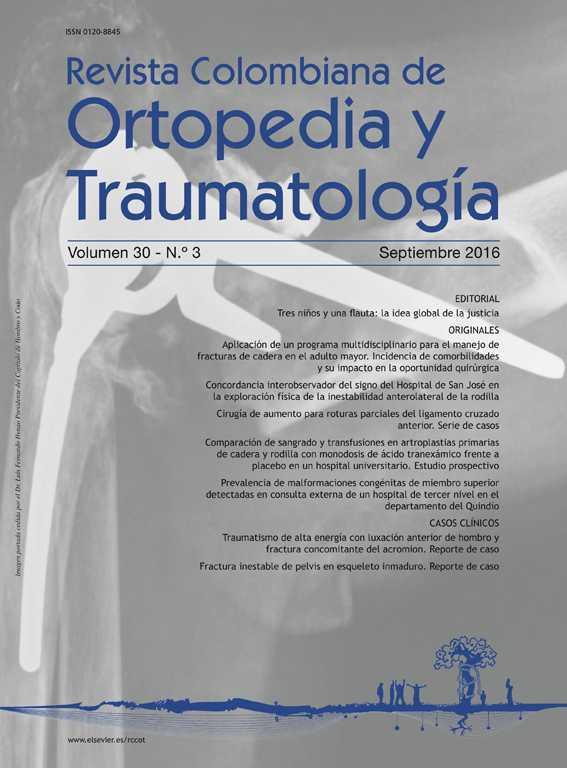Comparison of bleeding and transfusions in primary hip and knee arthroplasties with single doses of tranexamic acid vs. placebo in a University Hospital. A prospective study
DOI:
https://doi.org/10.1016/j.rccot.2016.10.004Keywords:
tranexamic acid, hip arthroplasty, knee arthroplastyAbstract
Background: Tranexamic acid is an antifibrinolitic which has been used for many years in orthopedic surgery, in orderto decrease bleeding during and after surgery. However, an administration protocol has not been established. The aim of our study was to determine if a monodosis of 20 mg/kg iv of tranexamic acid is effective in reducing peri-operative bleeding.
Materials and methods: This is a prospective, randomized, double blind study. 62 patients had been evaluated from June 2014 to December 2015. We measured preoperative and postoperative hematocrit and hemoglobin, days of stay in hospital and number of red cell unit transfusion. We looked for complications and adverse effects.
Results: We discovered that tranexamic acid group had less decrease in hematocrit and hemoglobin levels than control group. Tranexamic acid group had a mean drop of 7,9 hematocrit points and 2,7 g/dl hemoglobin level, whereas control group had a mean drop of 10,5 hematocrit points and 3,7 g/dl hemoglobin level. 20% of control group received blood cell transfusion, while only 1 of 32 cases in tranexamic acid group received blood cell transfusion. Stay in hospital was longer in control group.
Discussion: We concluded that a monodosis of 20 mg/kg iv of tranexamic acid is an effective protocol to reduce bleeding, transfusions, and stay in hospital in patients going under primary hip and knee arthroplasty. This is a prospective, randomized, double blind clinical trial.
Evidence level: I.
Downloads
References
Samama CM, Ravaud P, Parent F, Barré J, Merti P, Mismetti P. Epidemiology of venous thromboembolism after lowerlimb arthroplasty: the FOTO study. J Thromb Haemost. 2005;3:2006-14.
Carson JL, Duff A, Berlin JA, Lawrence VA, Poses RM, Huber EC. Perioperative blood transfusion and postoperative mortality. JAMA. 1998;279:199-205. https://doi.org/10.1001/jama.279.3.199
Carson JL, Duff A, Poses RM, Berlin JA, Spence RK, Trout R, et al. Effect of anaemia and cardiovascular disease on surgical mortality and morbidity. Lancet. 1996;348:1055-60. https://doi.org/10.1016/S0140-6736(96)04330-9
Scott Beattie W, Karkouti K, Wijeysundera D, Tait G. Risk associated with preoperative anemia in non-cardiac surgery. Anesthesiology. 2009;110:574-658. https://doi.org/10.1097/ALN.0b013e31819878d3
Cecil RL. Cecil Medicine. 23.a ed. Philadelphia: Goldman and Ausiello; 2008. p. 1326-8.
Cardone D, Klein AA. Perioperative blood conservation. Eur J Anaesthesiol. 2009;26:722. https://doi.org/10.1097/EJA.0b013e32832c5280
Callaghan JJ, O'Rourke MR, Liu SS. Blood management: issues and options. J Arthroplasty. 2005;20:51-4. https://doi.org/10.1016/j.arth.2005.03.018
Dunn CJ, Goa KL. Tranexamic acid: a review of its use in surgery and other indications. Drugs. 1999;57:1005. https://doi.org/10.2165/00003495-199957060-00017
Eubanks JD. Antifibrinolytics in major orthopaedics surgery. J Am Acad Orthop Surg. 2010;18:132. https://doi.org/10.5435/00124635-201003000-00002
Benoni G, Fredin H. Fibrinolytic inhibition with tranexamic acid reduces blood loss and blood transfusion after knee arthroplasty. J Bone Joint Surg Br. 1996;78:434-40. https://doi.org/10.1302/0301-620X.78B3.0780434
Benoni G, Carlsson A, Petersson C, Fredin H. Does tranexamic acid reduce blod loss in knee arthroplasty? Acta Orthop Scan. 1994 [Suppl 256]:101.
Jixiang T, Hong Ch, Qin L, Cheng Ch, Wei H. A meta-analysis of the effectiveness and safety of using tranexamic acid in primary unilateral total knee arthroplasty. J Surg Res. 2013;184: 880-7. https://doi.org/10.1016/j.jss.2013.03.099
Sukeik M, Alshryda S, Haddad FS, Mason JM. Systematic review and meta-analysis of the use of tranexamic acid in total hip replacement. J Bone Joint Surg Br. 2011, 93-B:39-46. https://doi.org/10.1302/0301-620X.93B1.24984
Ho KM, Ismail H. Use of intravenous tranexamic acid to reduce allogeneic blood transfusion in total hip and knee arthroplasty: A meta-analysis. Anaesth Intensive Care. 2003;31: 529-37. https://doi.org/10.1177/0310057X0303100507
Alshryda S, Sarda P, Sukeik M, Nargol A, Blenkinsopp J, Mason JM. Tranexamic acid in total knee replacement. A systematic review and meta-analysis. J Bone Joint Surg Br. 2011, 93-B:1577- 85. https://doi.org/10.1302/0301-620X.93B12.26989
Gandhi R, Evans H, Mahomed S, Mahomed N. Tranexamic acid and the reduction of blood loss in total knee and hip arthroplasty: a meta-analysis. BMC Research Notes. 2013;6:184. https://doi.org/10.1186/1756-0500-6-184
Benoni G, Lethagen S, Nilsson P, Fredin H. Tranexamic acid, given at the end of the operation, does not reduce postoperative blood loss in hip arthroplasty. Acta Orthop Scand. 2007;71:250-4. https://doi.org/10.1080/000164700317411834
Hynes M, Calder P, Scott G. The use of tranexamic acid to reduce blood loss during total knee arthroplasty. Knee. 2003;10: 375-7. https://doi.org/10.1016/S0968-0160(03)00044-9
Hynes M, Calder P, Rosenfeld P, Scott G. The use of tranexamic acid to reduce blood loss during total hip athroplasty: an observational study. Ann R Coll Surg Eng. 2005;87:99-101. https://doi.org/10.1308/147870805X28118
Bierbaum BE, Callaghan JJ, Galante JO, Rubash HE, Tooms RE, Welch RB. An analysis of blood management in patients having a total hip or knee arthroplasty. J Bone Joint Surg Am. 1999;82:2-10. https://doi.org/10.2106/00004623-199901000-00002
Guidance for the use of blood components. National Blood Transfusion Comitee. National Health Services (NHS). United Kingdom. April 2013.
Downloads
Published
How to Cite
Issue
Section
License
Copyright (c) 2024 Revista Colombiana de ortopedia y traumatología

This work is licensed under a Creative Commons Attribution 3.0 Unported License.




